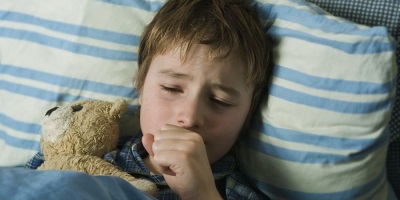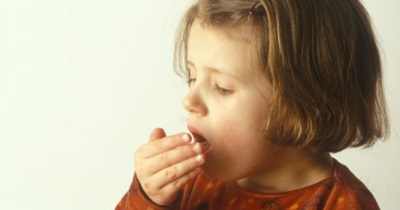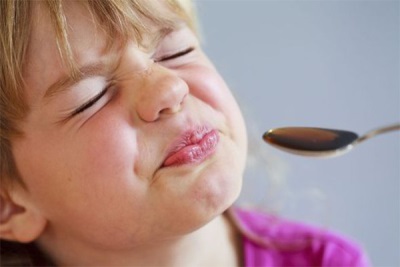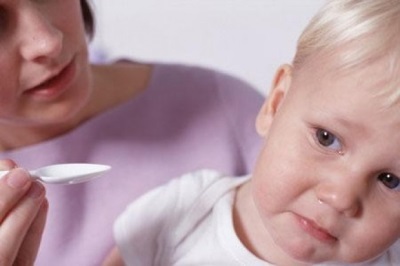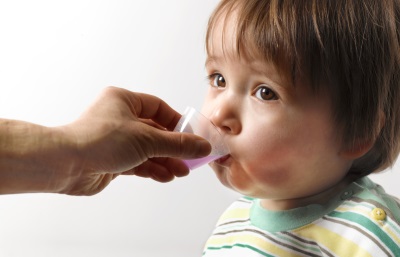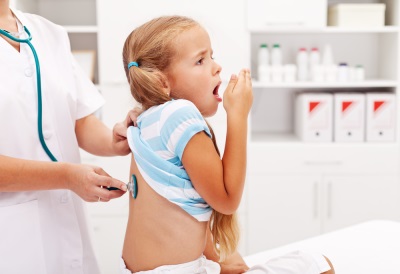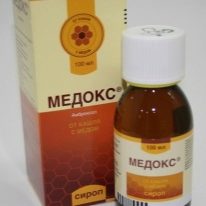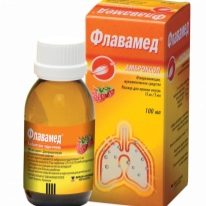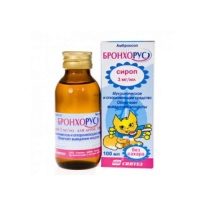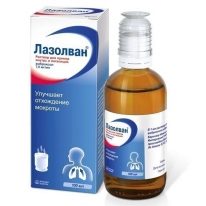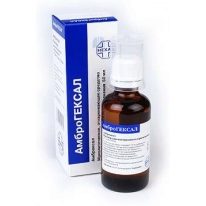Ambrobene for children
With a strong cough in a child, many doctors recommend mucolytic drugs. One of them is the German drug Ambrobene. What form of this medication is used in childhood and when is it worth giving Ambrobene to children?
Release form
Ambrobene is produced in the following forms:
- Syrup. This is the most convenient form for children, represented by a delicious raspberry clear solution, which is often colorless, but may be slightly yellow. It is sold in a dark bottle with a capacity of 100 ml, and the concentration of the active ingredient in 1 ml of syrup is 3 mg. For proper dosing, a plastic cup is present in the syrup in addition to the medicine bottle.
- Solution taken orally and used for inhalation. The concentration of the active substance in this form per 1 ml of solution is 7.5 mg of the drug. This Ambrobene is represented by a clear liquid poured into 100 ml vials. Also this colorless or odorless yellowish solution is sold in a smaller package - 40 ml.
- Solution intended for intravenous injections. It is also represented by a colorless transparent solution, which has no smell, but may be yellow. This drug is packaged in ampoules of 2 milliliters. Each of them contains 15 mg of the active ingredient (7.5 mg / 1 ml). One pack contains five ampoules.
- Pills, each of which contains 30 mg of active substance. One pack contains 20 or 50 such tablets packed in blisters of 10 pieces. They are round, white, convex on both sides, with a risk, according to which the tablet is easily divided into halves.
- Capsuleswhich feature is a long-term action. Each capsule contains 75 mg of the active ingredient. They have a transparent body and a brown lid, and inside contain white or light yellow granules. Such capsules are packaged in blisters of ten pieces, and one package includes 1-2 blisters.
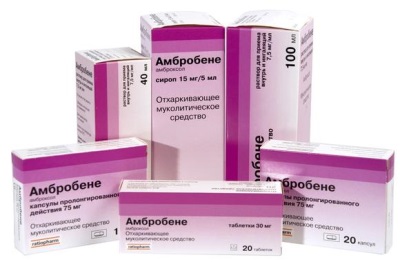
Composition
The main active compound in any of the forms of Ambrobene is ambroxol hydrochloride. Auxiliary substances in different versions of drugs differ:
- Syrup includes sorbitol, propylene glycol and water. To make such a preparation sweet, there is saccharin in its composition, and for a pleasant smell, the medicine contains raspberry flavoring.
- In the solution administered orally, there is potassium sorbate, water and hydrochloric acid.
- Additional components of the injection form are NaCl and citric acid. Also in this medicine there is Na hydrophosphate heptahydrate.
- The tablet form for solid form and density contains silica, corn starch, lactose in the form of monohydrate, and Mg stearate.
- In addition to ambroxol, MCC, silica, hypromellose, and a copolymer of ethacrylate with methacrylic acid are present inside the capsules, and the capsule itself is made of gelatin, titanium dioxide and dyes.
Ambrobene commercial:
Operating principle
Once in the human body, Ambrobene is transferred to the lung tissue, where the maximum concentration of the drug is observed.
Also, this drug can penetrate to the fetus and in breast milk. The action of Ambrobene after oral administration begins after half an hour, and the duration of the therapeutic effect can last up to 12 hours (time depends on dosage). If an injection method of administration is used, the therapeutic effect comes faster and lasts up to 10 hours.
Ambroxol in the composition of the drug dilutes too viscous secretion produced in the bronchi, due to which the phlegm moves away more easily. Reception Ambrobene has the following effect:
- It activates the synthesis of enzymes that break down substances in the composition of bronchial mucus. This affects the viscosity of sputum, with the result that its outflow from the respiratory tract is facilitated.
- Prevents sticking of cilia of cells of the mucous membrane of the bronchial tree.
- Stimulates the synthesis of the active substance, which does not allow the alveoli to stick together during expiration (surfactant).
- Neutralizes free radicals, protecting the body's cells from their damaging effects (this effect is called antioxidant).
Watch a video in which Dr. Komarosky shows you how to do a drainage massage to liquefy sputum. This method will help expectorating sputum and will be useful when you cough.
Indications
Any form of Ambrobene is used for acute or chronic diseases of the respiratory system, a symptom of which is a violation of sputum discharge. The drug is prescribed for:
- Bronchial asthma.
- Pneumonia.
- Laryngitis
- Bronchitis
- SARS.
- Bronchiectasis.
- Obstructive pulmonary pathologies.
Since Ambrobene has a positive effect on the synthesis of surfactant, one of the reasons for using this medicine will be the syndrome of respiratory disorders in a newborn child.
From what age can I give?
In pediatric practice, Ambrobene is used in babies from birth. The drug may even be prescribed to premature babies who have developed distress syndrome. In this case, treatment with such a medicine for children in the first 2 years of life must be monitored by a doctor. It is unacceptable to give Ambrobene to babies up to a year (for example, a 3-month crumbs or 5 months) without consulting a pediatrician.
Ambrobene tablet form is prescribed to children over 6 years old when the child can already swallow a pill without difficulty.. Due to the high dose of the medicine, Ambrobene capsules are not used in the treatment of children under 12 years of age.
Contraindications
Treatment of any form of Ambrobene is not recommended if the small patient has an intolerance to some component of the drug - both its active substance and any of the auxiliary compounds (for example, lactose present in the composition of the tablets).
Also, the drug does not give:
- With epilepsy and seizures.
- With peptic ulcer.
- With serious pathologies of the kidneys.
- With impaired liver function.
- With an excessive amount of sputum, which is not displayed due to a violation of motility in the bronchi.
If a child has any of these problems, the need for an appointment with Ambrobene should be weighed by a doctor, and the dosage requires correction. When problems with carbohydrate metabolism or diabetes mellitus is not recommended Ambrobene syrup.
Side effects
In the annotation to Ambrobene it is noted that the medicine can provoke:
- Dyspnea or nasal discharge.
- Drying of the oral mucosa, but sometimes the drug, on the contrary, can provoke the release of saliva in excess.
- Stool disorder, abdominal pain, nausea and other symptoms that are attributed to dyspepsia.
- Allergies that may manifest urticaria, swelling of facial tissues, fever or itching. In isolated cases, an anaphylactic reaction occurs.
- Weakness, increased blood pressure, difficulty urinating, headaches. These side effects occur in less than 1% of children.
Instructions for use
Ingestion
The drug in the form of a syrup, solution, capsules or tablets is recommended to be taken after meals. Syrup and the solution is metered with a measuring cup, washed down with water.The solution can be diluted not only with water, but also with another liquid (juice, tea). Tablets or capsules should be swallowed without chewing, followed by a liquid in a volume of about 200 ml.
How many days to take Ambrobene depends on the disease and its severity. If the medicine was not prescribed by a doctor, the use of the drug should not be longer than 5 days.
To make the drug more effective, it is important to pay attention to the drinking regime of a small patient. Babies who are treated with Ambrobene should be given plenty to drink. This makes the emphasis and Dr. Komarovsky.
Ambrobene capsules administered 1 capsule per day. Dosage Ambrobene tablets for children will be as follows:
For children from 6 to 11 years | 1/2 tablet |
For children 12 years and older | Whole tablet |
If the child is not yet 12 years old, then it is usually prescribed a double dose of a single dose, but in some diseases the doctor may prescribe it three times a day. Twelve-year-olds and older are prescribed the drug immediately 3 times a day, and after two or three days they evaluate the effectiveness of the treatment. Then a single dose can be increased to two tablets twice a day or reduced to 1 tablet 2 times a day.
Syrup is prescribed in this dose:
A child under two years old | Half a measuring cup (2.5 ml) per reception twice a day - only 15 mg of active ingredient. |
A child of two to five years old | Half a measuring cup (2.5 ml) per reception three times a day - only 22.5 mg of the active substance. |
Child sixteen twelve | On the whole measuring cup (5 ml) two or three times a day - only 30 or 45 mg of active ingredient. |
At the age of 12, the therapy starts with 10 ml of syrup per dose, which corresponds to two cups. The drug is given three times a day (only 90 mg of ambroxol), and after a few days, it is evaluated how it works. Further, the drug will be doubled, but the dosage is determined on the basis of effectiveness. With a sufficient effect, the child continues to give 10 ml of syrup (60 mg of active substance per day is obtained), and with unexpressed effects, the dose is increased to 20 ml of syrup (the daily dose of the active ingredient is 120 mg).
Ambrobene solution taken orally in a single dose:
At the age of six | 1 ml |
At 6-11 years old | 2 ml |
12 years or older | 4 ml |
In the first 2 years of life, the solution is given only after prescription twice a day. For children who are two years old, but have not yet reached the age of 6, three times recommended. Children from 6 to 12 years old can take the medicine twice a day or three times a day.
If three days of treatment with Ambrobene child solution over the age of 12 years, the drug did not give a good therapeutic effect, a single dosage is increased to 8 milliliters, and the medicine is given 2 times a day. With a sufficient effect, Ambrobene continues to give 4 milliliters, but they go on to a double dose.
Injections
The injection form Ambrobene is injected into a vein in the drop method. Inkjet injection is also possible, which should be very slow (minimum 5 minutes). To dilute the drug is allowed to use Ringer-Locke solution, saline or glucose solution.
To calculate the dosage you need to know the weight of the baby, because per 1 kg of body weight of the child requires 30 mg of ambroxol. This daily amount of medication is divided into 4 injections. After the disappearance of the acute symptoms, injectable Ambrobene should be replaced by using other forms, such as syrup or tablets.
Inhalation
Ambrobene solution for internal use can breathe through the nebulizer. Before the procedure, the drug is diluted in equal proportions with saline in order to sufficiently moisten the mucous membrane. It is also recommended to warm the treatment solution to body t °.
In order to prevent coughing, the child is offered to take quiet exhalations and inhalations, and for children with bronchial asthma, inhaling the use of bronchodilator is recommended to prevent spasm.
The course of treatment includes 1-2 inhalations per day for 4-5 days. For one procedure, take Ambrobene in solution in such a dose:
For children up to 2 years old | 1 ml |
For babies 2-6 years | 2 ml |
For a child over six years old | 2-3 ml |
For details on the principle of operation of Ambrobene during inhalation, see the video:
Overdose
If you exceed the recommended doses of Ambrobene, it can lead to nausea, drooling, an attack of vomiting, an agitated state, loose stools and a decrease in blood pressure. In the case when an overdose is detected within 2 hours after Ambrobene is drunk in excess, the patient should have a gastric lavage. In other situations with a deteriorated general condition, you need to consult a doctor.
Interaction with other drugs
- Assign Ambrobene with a wet cough, along with antitussives, whose action is to suppress the cough reflex, can be dangerous. This combination of drugs increases the risk of stagnation in the bronchi, which will worsen the child's condition.
- The use of Ambrobene along with some antibiotics leads to an increase in their concentration in secret, which is released in the bronchi. A similar effect has been noted with Cefuroxime and Amoxicillin. Ambrobene also acts on Erythromycin and Doxycycline. This interaction is often used when a child has a bacterial infection of the respiratory tract.
- The solution for the introduction of a vein should not be mixed with drugs, the pH of which exceeds 6.3, otherwise the formation of a precipitate.
Terms of sale
You can buy Ambrobene for children in a pharmacy without a prescription, except for the injection form. If you need to buy ampoules of such a drug, you will have to show the doctor’s prescription.
The average price of 20 tablets Ambrobene is 150 rubles, packs of 5 ampoules are 180 rubles, and 20 capsules are approximately 250 rubles. For a 100-milliliter bottle of solution for inhalation you need to pay about 120 rubles, and a bottle of syrup of the same volume will cost 170 rubles.
Storage conditions and shelf life
In order for Ambrobene not to lose its medicinal properties, it is worthwhile to find a dry place for storing such a drug, which cannot be accessed by babies. The medicine should be stored at a temperature below + 25 ° С.
The shelf life of all forms of Ambrobene is 5 years. However, such a long storage of syrup is possible only if it has not been opened. After the package has been opened, the medicine must be used within 1 year.
Reviews
In most cases, mothers who have treated their children with a form of Ambrobene speak positively about this medicine. Many reviews include information about a fairly quick effect in both dry and barking coughs and wet coughs. Sometimes children do not like syrup or solution, but most of the kids do not protest against these types of drugs.
One of the main advantages of the drug is a large variety of forms that allows you to choose the right one for a very young child or older children. Tolerability of the drug in children is mostly good, and side effects are rare. As for the price, some parents attribute Ambrobene to inexpensive medicines, while others believe that, if desired, you can pick up a cheaper counterpart.
Analogs
If you need to replace Ambrobene, you can use other drugs with the same active substance. It may be:
- Lasolvan. Such a German medicine is represented by a variety of forms - ingested solution, syrup with two different dosages, lozenges and tablets.
- Ambroxol. This domestic drug is available in syrup (in two dosages) and tablets, as well as in solution.
- Ambrohexal. Such a drug company Sandoz is available in syrup and capsules.There are also tablets and a form of solution that can be used for inhalation or taken orally.
- Flamed. Such a drug Ambroxol from Germany is available in solution and tablets.
- Bronchus. Such a Russian drug is represented by syrup.
- Medox. This medicine from the Czech Republic is represented by tablets and syrup.
Also in the treatment of cough replacement ambroxol containing drugs may be other drugs with similar therapeutic effects. The most popular are:

